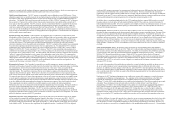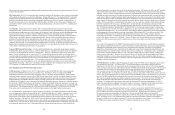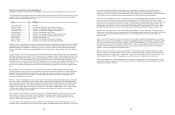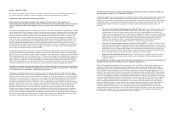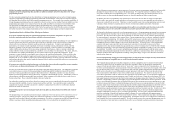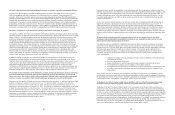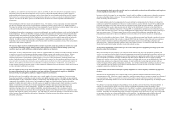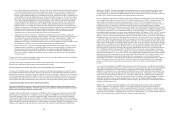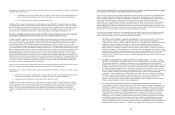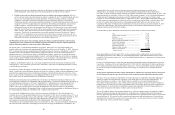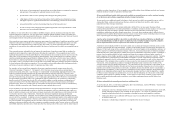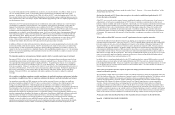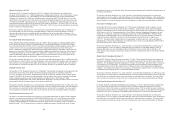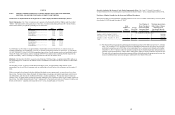Dish Network 2012 Annual Report Download - page 22
Download and view the complete annual report
Please find page 22 of the 2012 Dish Network annual report below. You can navigate through the pages in the report by either clicking on the pages listed below, or by using the keyword search tool below to find specific information within the annual report.
32
32
x Intercompany agreements with EchoStar. We have entered into certain agreements with EchoStar pursuant
to which we provide EchoStar with certain management, administrative, accounting, tax, legal and other
services, for which EchoStar pays us our cost plus a fixed margin. In addition, we have entered into a
number of intercompany agreements covering matters such as tax sharing and EchoStar’s responsibility for
certain liabilities previously undertaken by us for certain of EchoStar’s businesses. We have also entered
into certain commercial agreements with EchoStar pursuant to which EchoStar, among other things, sells
set-top boxes and related equipment to us at specified prices. The terms of certain of these agreements
were established while EchoStar was a wholly-owned subsidiary of us and were not the result of arm’s
length negotiations. The allocation of assets, liabilities, rights, indemnifications and other obligations
between EchoStar and us under the separation and other intercompany agreements we entered into with
EchoStar, in connection with the Spin-off, may have been different if agreed to by two unaffiliated parties.
Had these agreements been negotiated with unaffiliated third parties, their terms may have been more
favorable, or less favorable, to us. In addition, conflicts could arise between us and EchoStar in the
interpretation or any extension or renegotiation of these existing agreements.
x Additional intercompany transactions. EchoStar or its affiliates have and will continue to enter into
transactions with us or our subsidiaries or other affiliates. Although the terms of any such transactions will
be established based upon negotiations between EchoStar and us and, when appropriate, subject to the
approval of a committee of the non-interlocking directors or in certain instances non-interlocking
management, there can be no assurance that the terms of any such transactions will be as favorable to us or
our subsidiaries or affiliates as may otherwise be obtained between unaffiliated parties.
x Business opportunities. We have historically retained, and in the future may acquire, interests in various
companies that have subsidiaries or controlled affiliates that own or operate domestic or foreign services
that may compete with services offered by EchoStar. We may also compete with EchoStar when we
participate in auctions for spectrum or orbital slots for our satellites. In addition, EchoStar may in the
future use its satellites, uplink and transmission assets to compete directly against us in the subscription
television business.
We may not be able to resolve any potential conflicts, and, even if we do so, the resolution may be less favorable to
us than if we were dealing with an unaffiliated party.
Other than certain joint arrangements between DISH Network and EchoStar, we do not have agreements with
EchoStar that would prevent either company from competing with the other.
We rely on key personnel and the loss of their services may negatively affect our businesses.
We believe that our future success will depend to a significant extent upon the performance of Charles W. Ergen,
our Chairman, and certain other executives. The loss of Mr. Ergen or of certain other key executives could have a
material adverse effect on our business, financial condition and results of operations. Although all of our executives
have executed agreements limiting their ability to work for or consult with competitors if they leave us, we do not
have employment agreements with any of them. To the extent our officers are performing services for EchoStar,
this may divert their time and attention away from our business and may therefore adversely affect our business.
Acquisition and Capital Structure Risks Affecting our Business
We made a substantial investment to acquire certain 2 GHz wireless spectrum licenses and other assets from
DBSD North America and TerreStar. We will be required to make significant additional investments or partner
with others to commercialize these licenses and assets.
On March 2, 2012, the FCC approved the transfer of 40 MHz of 2 GHz wireless spectrum licenses held by DBSD
North America and TerreStar to us. On March 9, 2012, we completed the DBSD Transaction and the TerreStar
Transaction, pursuant to which we acquired, among other things, certain satellite assets and wireless spectrum
licenses held by DBSD North America and TerreStar. In addition, during the fourth quarter 2011, we and Sprint
entered into the Sprint Settlement Agreement pursuant to which all issues then being disputed relating to the DBSD
Transaction and the TerreStar Transaction were resolved between us and Sprint, including, but not limited to, issues
relating to costs allegedly incurred by Sprint to relocate users from the spectrum then licensed to DBSD North
33
33
America and TerreStar. Pursuant to the Sprint Settlement Agreement, we made a net payment of approximately
$114 million to Sprint. The total consideration to acquire these assets was approximately $2.860 billion. This
amount includes $1.364 billion for the DBSD Transaction, $1.382 billion for the TerreStar Transaction, and the net
payment of $114 million to Sprint pursuant to the Sprint Settlement Agreement.
Our consolidated FCC applications for approval of the license transfers from DBSD North America and TerreStar
were accompanied by requests for waiver of the FCC’s Mobile Satellite Service (“MSS”) “integrated service” and
spare satellite requirements and various technical provisions. The FCC denied our requests for waiver of the
integrated service and spare satellite requirements but did not initially act on our request for waiver of the various
technical provisions. On March 21, 2012, the FCC released a Notice of Proposed Rule Making (“NPRM”)
proposing the elimination of the integrated service, spare satellite and various technical requirements attached to the
2 GHz licenses. On December 11, 2012, the FCC approved rules that eliminated these requirements and gave notice
of its proposed modification of our 2 GHz authorizations to, among other things, allow us to offer single-mode
terrestrial terminals to customers who do not desire satellite functionality. On February 15, 2013, the FCC issued an
order, which will become effective on March 7, 2013, modifying our 2 GHz licenses to add terrestrial operating
authority. The FCC’s order of modification has imposed certain limitations on the use of a portion of this spectrum,
including interference protections for other spectrum users and power and emission limits that we presently believe
could render 5 MHz of our uplink spectrum effectively unusable for terrestrial services and limit our ability to fully
utilize the remaining 15 MHz of our uplink spectrum for terrestrial services. These limitations could, among other
things, impact the finalization of technical standards associated with our wireless business, and may have a material
adverse effect on our ability to commercialize these licenses. The new rules also mandate certain interim and final
build-out requirements for the licenses. By March 2017, we must provide terrestrial signal coverage and offer
terrestrial service to at least 40% of the aggregate population represented by all of the areas covered by the licenses
(the “2 GHz Interim Build-out Requirement”). By March 2020, we must provide terrestrial signal coverage and
offer terrestrial service to at least 70% of the population in each area covered by an individual license (the “2 GHz
Final Build-out Requirement”). If we fail to meet the 2 GHz Interim Build-out Requirement, the 2 GHz Final Build-
out Requirement will be accelerated by one year, from March 2020 to March 2019. If we fail to meet the 2 GHz
Final Build-out Requirement, our terrestrial authorization for each license area in which we fail to meet the
requirement will terminate. In addition, the FCC is currently considering rules for a spectrum band that is adjacent
to our 2 GHz licenses, known as the “H Block.” If the FCC adopts rules for the H block that do not adequately
protect our 2 GHz licenses, there could be a material adverse effect on our ability to commercialize the 2 GHz
licenses.
As a result of the completion of the DBSD Transaction and the TerreStar Transaction, we will likely be required to
make significant additional investments or partner with others to, among other things, finance the commercialization
and build-out requirements of these licenses and our integration efforts including compliance with regulations
applicable to the acquired licenses. Depending on the nature and scope of such commercialization, build-out, and
integration efforts, any such investment or partnership could vary significantly. Additionally, recent consolidation
in the wireless telecommunications industry, may, among other things, limit our available options, including our
ability to partner with others. There can be no assurance that we will be able to develop and implement a business
model that will realize a return on these spectrum licenses or that we will be able to profitably deploy the assets
represented by these spectrum licenses, which may affect the carrying value of these assets and our future financial
condition or results of operations.
While the FCC’s recently issued rules applicable to our 2 GHz authorizations no longer require an integrated
satellite component, we may use these satellites in our commercialization of wireless spectrum or for other
commercial purposes. In addition, T1, which we acquired through the TerreStar Transaction, is subject to certain
Canadian satellite regulations, including, among other things, an integrated satellite component. We are evaluating
our options for these satellites. Depending on our eventual use of these satellites, we may need to impair them in the
future, which could materially and adversely affect our future results of operations.



